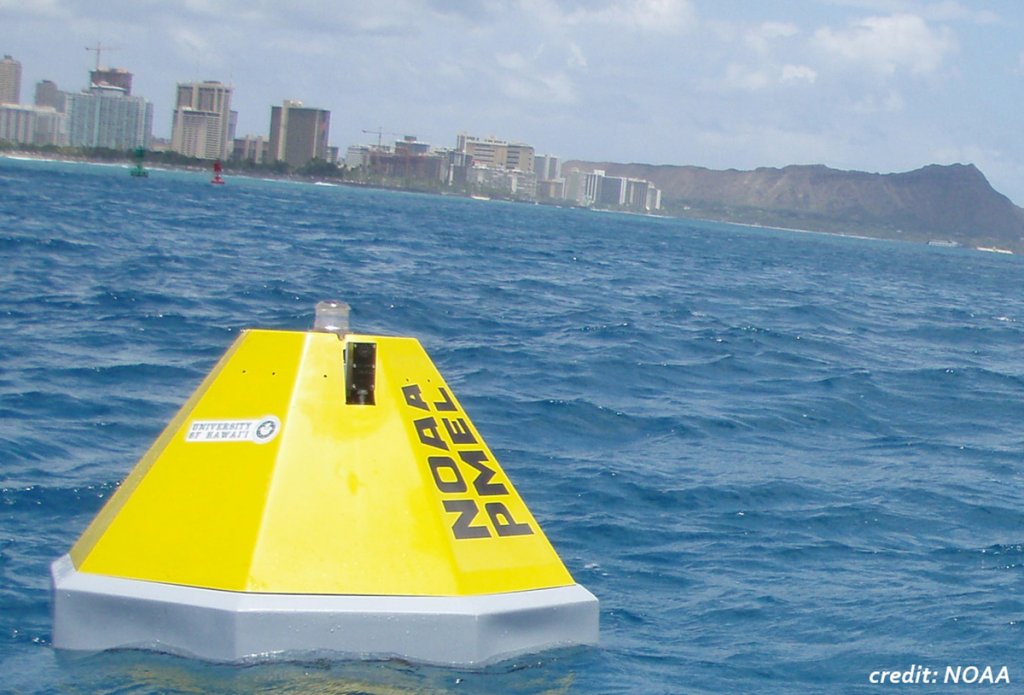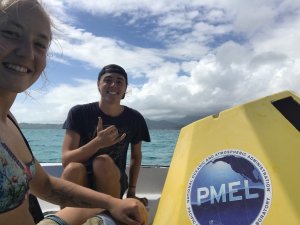CO2 measurements on the Oʻahu Coast
by Lucie Knor

Aloha! My name is Lucie Knor and I am part of the longest-running time series project on carbon dioxide (CO2) in the coastal ocean. It is located right here in Hawaiʻi. There are currently four buoys installed around O’ahu, two on the windward side, inside and just outside of the fringing reef in Kāneʻohe Bay, and two on the south shore, at the mouth of the Ala Wai Canal and in front of Kakaʻako Waterfront park. The next time you’re out on a boat or paddleboard around Oʻahu, keep an eye out for these big yellow buoys– you might spot one of them.
The buoys all include a set of instruments that measure different characteristics of the surface water. They collect data on temperature, salinity, oxygen, and on the number of particles and plankton floating in the water.
The most important thing measured by the buoys is carbon dioxide (CO2), a gas that you have probably heard of, particularly in stories about climate change. CO2 emissions from burning fossil fuels are the main cause of global warming, and a topic of great concern for both scientists and the general public. Although people talking about global warming mostly discuss the CO2 that is released into the atmosphere, a lot of that CO2 actually makes its way into the ocean. The atmosphere and ocean constantly exchange gases, including CO2, to distribute them evenly between the two reservoirs. On the one hand, that is a good thing: CO2 that enters the ocean is taken out of the air for a long time, which means that the ocean actually removes some greenhouse gases and reduces the potential to cause warming. On the other hand, the increase in dissolved CO2 changes the chemistry of the water, causing ocean acidification, which is a real problem to many ocean ecosystems.
The pH of the ocean, which indicates how acidic the water is, has been decreasing as steadily as CO2 has been rising, all over the world. (The lower the pH, the higher the acidity.) This is a problem for many of the animals living in the ocean, especially the ones that have shells and hard parts made of calcium carbonate, a mineral which breaks down in acidic conditions. This means that when water gets more acidic, shells are harder to make and become thinner, and when the pH is very low (very acidic), they can even dissolve. Many mussels and snails, and also small plankton which have shells, are impacted. Corals like the ones in Kāneʻohe Bay are struggling to survive the water temperatures increasing to levels higher than the corals can normally tolerate, and acidification of the ocean water may only make things worse.
Because absorbed atmospheric CO2 is the main culprit of ocean acidification, it is important to monitor the amount of the gas in the coastal ocean. We need long-running studies like the Hawaiʻi one to be able to determine how much CO2 is natural, how much of human-made CO2 ends up in the ocean, and how marine life, such as corals, are impacted by different concentrations.

Over the last few years, scientists working on this project have come up with some very interesting results about how CO2 at our buoys varies because of different influences. For a long time, scientists thought that CO2 concentrations in the ocean were relatively stable, but all around O’ahu, we have observed surprisingly large changes. The shifts are not only in the long-term because of climate change, but also between day and night, and between the seasons.
Some plankton photosynthesize, like trees on land, converting CO2 to oxygen, but only when there is enough light. So plankton takes up CO2 from the water during the day. But because the ocean is always trying to balance its CO2 with the atmosphere’s, the water dissolves more CO2 from the air to replace what is absorbed by plankton photosynthesis. After a big rainstorm, the soil and dirt that is washed into the ocean delivers nutrients for plankton. With so many nutrients suddenly available, plankton can do a lot more photosynthesis than normal, causing more atmospheric CO2 to be absorbed by the ocean right after big storms.
When all these plankton die, however, the products of the photosynthesis are broken down, using oxygen and releasing CO2 back into the water. So at different points in time, the event of a storm can create very different ocean CO2 concentrations, depending on which processes are dominating.
If we only measured CO2 once every few weeks or months, we would miss these complicated short-term changes. It would also be harder to understand the effects of long-term processes, like global warming, if we didn’t know what kind of fluctuations are normal within a year or even a week. More data collected frequently helps us understand the natural changes in the coastal ocean and how humans are impacting the system. That is why we have our buoys set up to measure CO2 almost all the time. You can even look at what the concentrations are doing today out our stations Ala Wai, Kilo Nalu, and CRIMP2, on this website: https://www.pmel.noaa.gov/co2/map/text
The next time there is a big storm, just go ahead and check what happens!

